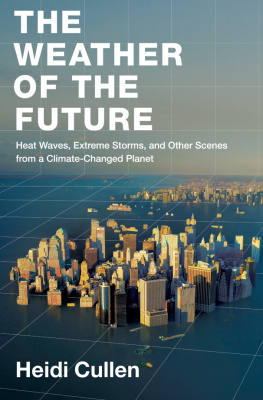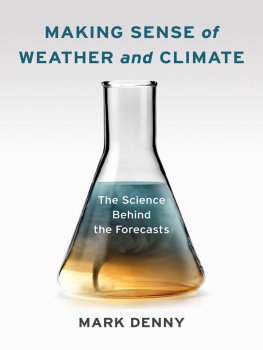THE NEW NATURALIST LIBRARY
CLIMATE
AND
WEATHER
JOHN A. KINGTON


EDITORS
SARAH A. CORBET, S C D
P ROF. RICHARD WEST, S C D, FRS, FGS
DAVID STREETER, MBE, FIB IOL
JIM FLEGG, OBE, FIH ORT
P ROF. JONATHAN SILVERTOWN
*
The aim of this series is to interest the general reader in the wildlife of Britain by recapturing the enquiring spirit of the old naturalists. The editors believe that the natural pride of the British public in the native flora and fauna, to which must be added concern for their conservation, is best fostered by maintaining a high standard of accuracy combined with clarity of exposition in presenting the results of modern scientific research.
Contents
G ILBERT WHITE OBSERVED IN HIS CLASSIC BOOK The Natural History of Selborne, that since the weather of a district is undoubtedly part of its natural history I shall make no further apology for the four following letters The Editors of the New Naturalist Library took the same view with the publication in 1952 of Gordon Manleys Climate and the British Scene. This successful book reflected the wide field experience of the author and ran into several impressions, finally becoming out of print in 1980.
Since the publication of Manleys book, much has happened in our knowledge of climate and weather. The recording of relations between weather and natural history has continued to be of constant interest to natural history societies, local and national, with the weather a continual and essential backdrop to accounts of natural history. But the significance of this backdrop has been very much widened by our increased knowledge of climate change and its nature, the effects of such change in terms of flora, fauna and biodiversity and also by the increased knowledge of historical climates and weather events, a field greatly advanced by the pioneer contributions of Hubert Lamb.
The author of Climate and Weather, John Kington, has had a long involvement with these developments, with experience as a synoptic meteorologist in the Meteorological Office, and later researching historical climatology in the renowned Climatic Research Unit in the University of East Anglia.
This book is divided into two very different but related parts, the first describing and discussing the significant topics which determine our climate and weather, the second a chronology of climatic history since the 1st century BC. The notable year-by-year account puts our present experience of weather into striking perspective, and of course reflects circumstances that will have affected our fauna and flora in times past. This book is a welcome and timely addition to the New Naturalist Library.
Lying throughout within the domain of the westerlies, beneath the sinuosities of that upper wave-pattern that girdles the Northern Hemisphere, the moist and temperate climate of the British Isles has been described by many authors. Indeed, no climate in the world has been more provocative of comment. By some, it has been described as the best in the world. For others, the astonishing variety of small-scale effects that it can and does repeatedly provide, induces resigned tolerance, irritation, or downright dislike, accompanied by declarations that the British Isles have no climate, but merely weather.
Gordon Manley, The Climate of the British Isles, 1970
T HE TWENTY - SECOND VOLUME IN THE N EW N ATURALIST L IBRARY , Professor Gordon Manleys Climate and the British Scene, was published almost 60 years ago, and the enduring qualities of that renowned text have stood the test of time. The purpose of this new book is to present subsequent developments and discoveries made in the study of the climate and weather of the British Isles, with particular reference to the research that I carried out at the Climatic Research Unit (CRU) , School of Environmental Sciences, University of East Anglia, Norwich, following studies under Manley at the University of London.
Besides the outstanding work of Manley, our knowledge and understanding of the climate and weather of the British Isles owes much to the efforts of Professor Hubert Lamb, founding Director of the CRU in 1971.
For instance, his study of historic storms presents a definitive account of the great windstorms that have affected the region and surrounding sea areas over the past 500 years. As one of the first meteorologists to be invited to join the staff of the CRU, I had the privilege to work with Lamb and benefit from his wide expertise in historical and synoptic climatology, particularly with the reconstruction of past circulation patterns and the classification of British Isles weather types.
I am grateful to HarperCollins for the opportunity to write this book, and to the Senior Editor, Julia Koppitz, Professor Richard West FRS and my wife, Beryl, for their advice and encouragement in seeing it through to publication. Mike Salmon (CRU) is thanked for preparing Figures 17-19.
PART I
Principal Acts in the Climatic Drama
CHAPTER 1
The Cimate and Weather of the British Isles
It is commonly observed, that when two Englishmen meet, their first talk is of the weather; they are in haste to tell each other, what each must already know, that it is hot or cold, bright or cloudy, windy or calm.
Samuel Johnson, 1758
INTRODUCTION
T HIS BOOK IS ABOUT THE CLIMATE AND WEATHER OF THE B RITISH I SLES , and the subject is essentially treated in the light of the authors experience as a synoptic meteorologist in the Meteorological Office, and as a historical climatologist in the Climatic Research Unit at the University of East Anglia. Developments made in climatology since Gordon Manley wrote his New Naturalist volume on Climate and the British Scene (Fig. 1) in 1952 are featured, together with the increasing concern, in both public and scientific circles, about the impact of climatic change on our way of life today and in the future. The book closes in the year 2000.
comprises chapters on the properties of the atmosphere and its circulation, the key players in the climate and weather of these islands, seasonal characteristics, sources of meteorological data, historical weather mapping, cloud study, phenology, climatic trends, anomalies and extremes, and climatic change.
However, first, it is desirable that a clear distinction should be made between the study of climate and that of weather. While climate is a summary of the weather conditions over an extended period of perhaps 30 or 40 years, weather is the state of the atmosphere at any one time, or over a short spell such as a day or a week. Climate is sometimes defined as average weather but a straightforward mean can conceal notable occurrences. For example, while a very warm summer may have been the most memorable weather event during a year, its thermal anomaly can be lost in that years average statistics of temperature.
In addition to examining weather as experienced in the British Isles on a daily to weekly basis and its characteristics related to large-scale synoptic situations, the book also reviews the many ways that people have observed and recorded weather conditions down the ages, using ever more sophisticated methods and instruments. It is a story based on a rich and varied resource stretching back 2000 years. This approach has allowed climatic trends, anomalies and extremes to be identified over the past two millennia.
As discussed in the region lies in the path of air-mass convergence between warm subtropical and cold polar airflows. At this convergence zone, the polar front, the less dense warm air rises over the denser cold air, producing the typical weather phenomena associated with this situation, that is, fronts, depressions and rain. As a result, the climate of the British Isles can be very changeable, and various types of weather may be experienced even within the short time span of a single day. In general, however, the climate of the region is relatively mild for its latitude, since it is influenced by the North Atlantic Drift that has its origin as the Gulf Stream, the warm ocean current that develops in the Gulf of Mexico and then flows northeast across the Atlantic. In contrast, Newfoundland, on the west side of the North Atlantic at similar latitude to the British Isles, can be up to 10 C (18 F) colder in winter.
Next page







